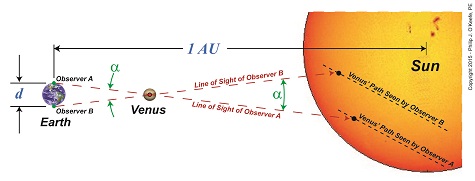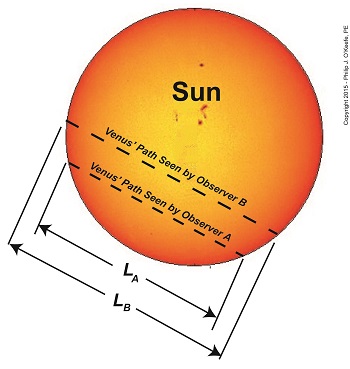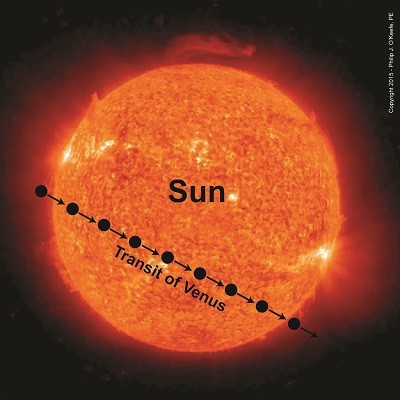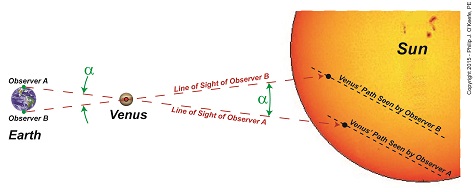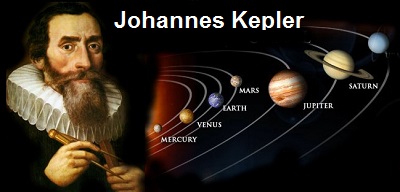|
We’ve been working on calculating Earth’s distance to the sun and discussing how past scientists, including Johannes Kepler and Edmund Halley, contributed to the discussion. Today we’ll see how Halley used his theory on the transit of Venus together with Kepler’s Third Law of Planetary Motion and combined them with known mathematical principles to solve the riddle of this enormous distance, known as one astronomical unit, or AU. Halley’s solution began with stationing two observers with telescopes aimed at Venus on opposite sides of the Earth. Their different lines of sight would cause the principle of parallax to come into play, resulting in them seeing Venus from different perspectives. Their sight would converge at Venus’ center and an angle, α, would form between them. Halley posited that if this angle could be measured, it would be an important first step in calculating the distance between Earth and the sun. See Figure 1. Due to their differing perspectives, Observer A would see Venus traveling a path lower on the sun’s face, while Observer B would see it following a path higher up. See Figure 2. The net result was that the length, LA, of Venus’ path as seen by Observer A was significantly shorter than length, LB, of Venus’ path as seen by Observer B. Because of this, Observer B would have seen Venus pass in front of the sun before Observer A. These differing observations meant that even if both observers were to set their telescopic crosshairs on Venus at the exact same moment it became visible to each of them, it would serve no purpose, because they lacked a common point of reference at which to aim in order to take measurements. This fact made measuring the angle α with a physical device such as a protractor impossible. So Halley gave up on the idea of physically measuring α. Instead, he proposed calculating it based on the time it took for Observers A and B to watch Venus traverse the sun’s face from one side to the other along each of their observational paths. Next time we’ll see how Halley put his idea to work to calculate α and used it in conjunction with Kepler’s Third Law to calculate the AU.
____________________________________
|
Posts Tagged ‘Kepler’s Third Law’
The Transit of Venus from Different Perspectives
Wednesday, June 3rd, 2015The Transit of Venus
Monday, May 18th, 2015|
Last time we learned of Johannes Kepler’s Third Law of Planetary Motion and his development of the astronomical unit (AU) and how these contributed to bringing ancient scientists a step closer to calculating Earth’s distance to the sun. Today we’ll see why Kepler’s focus on Venus, specifically its travel through space in relation to Earth and the sun — the so-called transit of Venus — would become the crucial element to solving the puzzle. Astronomers had previously used the Earth itself as an optical rangefinder to calculate distance to the moon. But unlike the moon which is relatively close to Earth, the sun is many tens of millions of miles away, too distant to be used in that manner. When it came to finding the distance from Earth to its sun, they were stumped. Then in 1716 Edmund Halley had the insight to combine Kepler’s Third Law and the parallax principle with Venus’ orbital journeys to devise an ingenious solution to the problem. The transit of Venus, first predicted by Kepler in 1627, is a rare astronomical phenomenon which only occurs every 243 years. At this time Venus becomes clearly visible from Earth and appears as a black dot traveling a straight path across the fiery backdrop of the sun’s surface. Figure 1 shows this phenomenon as it would look from Earth. According to Halley’s plan, two observers with telescopes would be positioned on opposite sides of the Earth. Due to the principle of parallax their lines of sight would provide different perspectives of Venus’ path. See Figure 2. From the perspective of Observer B, Venus’s path would appear higher on the sun’s face than the path seen from the perspective of Observer A. As their lines of sight converge on Venus’ center, an angle forms between them, which we’ll name α. The same angle forms as they look past Venus to the sun in its backdrop. Halley theorized that if the angle α could be measured, Kepler’s Third Law could be used together with trigonometry to calculate the distance between Earth and the sun, Kepler’s so-called AU. We’ll review Halley’s methodology next time.
____________________________________
|
Kepler’s Third Law Of Planetary Motion
Wednesday, December 31st, 2014|
Edmund Halley was faced with a real puzzle when he began his quest to determine the distance of Earth from the sun. One of the pieces to solving that puzzle came from the work of a German mathematician, astronomer and astrologer named Johannes Kepler. Early in the 17th Century, Kepler spent a lot of time observing the planets in our solar system as they orbited the sun. He discovered that by taking note of the time it took for a planet to make one orbit around the sun, he could determine its relative distance from it. He then compared his findings with other planets, noting the time it took for each to make this same journey. His discovery would come to be known as Kepler’s Third Law of Planetary Motion. But what exactly is meant by a planet’s “relative distance from the sun”? In essence, it means that interplanetary distances, like just about everything else, are relative. Put another way, heavenly bodies can be said to be a distance X relative to another heavenly body if you establish a value for X, whether it’s numerical or otherwise. In Kepler’s case, X would be the unknown value of a so-called astronomical unit (AU), where one AU is equal to the unknown distance from Earth to the sun. Represented in equation form, this distance is: rEarth-sun = 1 AU This relative marker of distance could then be used to show how far the other planets are from the sun, relative to Earth’s distance from the sun, the AU. Kepler’s astronomical unit is simply a placeholder term for an unknown quantity, similar to any other unknown variable that might be used in an algebraic equation. For example, Kepler observed the orbits of Venus and Mars and determined their relative distances to the sun to be: rVenus-sun = 0.72 × 1 AU = 0.72 AU rMars-sun = 1.5 × 1 AU = 1.5 AU In other words, Venus’ distance from the sun is just under three quarters of Earth’s and Mars is one and a half times Earth’s distance from the sun. In this way, Kepler was able to determine the relative distances from the sun in AU for all the observable planets in our solar system. Kepler felt sure that one day scientists would be able to accurately measure Earth’s distance from the sun, and when they accomplished this they could employ his astronomical unit system to determine distances between other planets in our solar system and the sun. Next time we’ll introduce the principle of parallax and see how Halley used this optical effect to devise a method for assigning a value to Kepler’s unknown AU. ____________________________________ |
